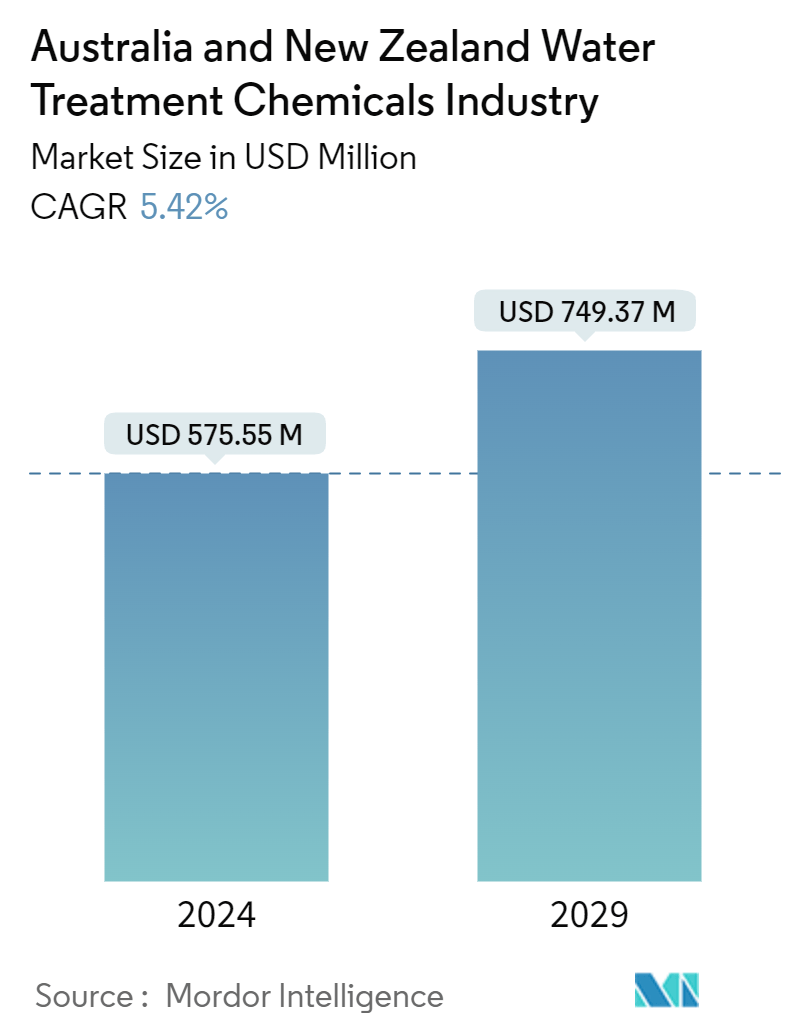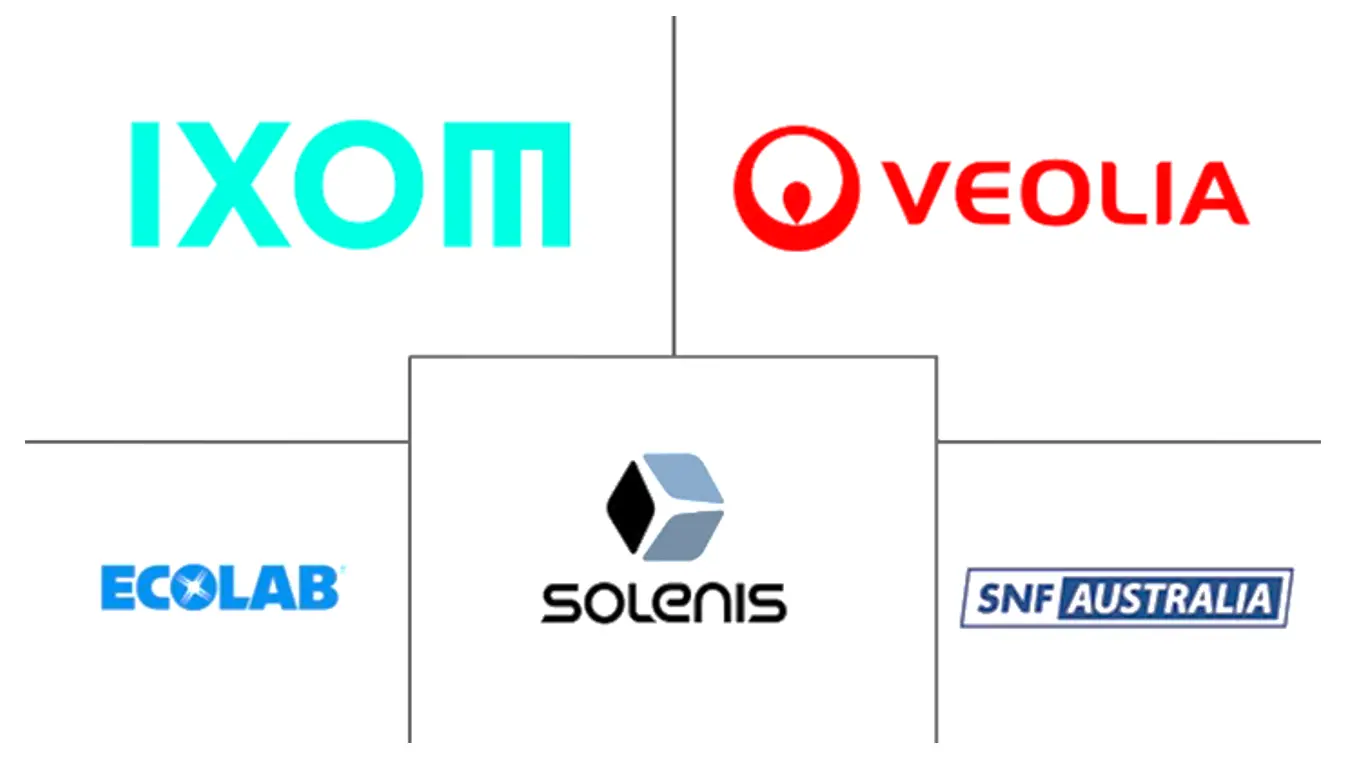Market Size of Australia & New Zealand Water Treatment Chemicals Industry

| Study Period | 2019 - 2029 |
| Base Year For Estimation | 2023 |
| Forecast Data Period | 2024 - 2029 |
| Market Size (2024) | USD 575.55 Million |
| Market Size (2029) | USD 749.37 Million |
| CAGR (2024 - 2029) | 5.42 % |
| Market Concentration | High |
Major Players
*Disclaimer: Major Players sorted in no particular order |
Australia & New Zealand Water Treatment Chemicals Industry Market Analysis
The Australia & New Zealand Water Treatment Chemicals Industry is expected to grow from USD 575.55 million in 2024 to USD 749.37 million by 2029, at a CAGR of 5.42% during the forecast period (2024-2029).
Factors such as increasing pollution of ground and surface water, heightened demand from power and industrial sectors, and proactive government measures toward reliable wastewater management are expected to drive the demand for water treatment chemicals in Australia & New Zealand during the forecast period.
However, the hazardous nature of hydrazine and emerging chemical-free alternatives to water treatment chemicals are expected to hinder the market's growth.
Nevertheless, the shifting focus toward green chemicals will likely create lucrative growth opportunities for the market studied.
Australia & New Zealand Water Treatment Chemicals Industry Industry Segmentation
Water treatment is a process that extracts or reduces the level of pollutants and undesirable components from water to make it suitable for use. The chemicals used in this method are referred to as water treatment chemicals.
The water treatment chemicals market is segmented by product and end-user industry. The market is segmented by product type, which includes coagulants and flocculants, defoamer and defoaming agents (antifoams), corrosion and scale inhibitors, biocide and disinfectants, pH conditioners/adjusters, and other product types. By end-user industry, the market is segmented into power generation, oil and gas, chemical manufacturing, mining and mineral processing, municipal, food and beverage, pulp and paper, and other end-user Industries. The report also covers the market size and forecasts in revenue (USD) for all the above segments.
| By Product Type | |
| Biocides and Disinfectants | |
| Coagulants and Flocculants | |
| Corrosion and Scale Inhibitors | |
| Defoamers and Defoaming Agents | |
| pH Conditioners/Adjusters | |
| Other Product Types |
| By End-user Industry | |
| Power Generation | |
| Oil and Gas | |
| Chemical Manufacturing | |
| Mining and Mineral Processing | |
| Municipal | |
| Food and Beverage | |
| Pulp and Paper | |
| Other End-user Industries |
Australia & New Zealand Water Treatment Chemicals Industry Size Summary
The water treatment chemicals market in Australia and New Zealand is poised for significant growth, driven by increasing pollution of ground and surface water, rising demand from power and industrial sectors, and government initiatives aimed at effective wastewater management. Despite challenges posed by the COVID-19 pandemic, which temporarily hindered industry expansion due to resource shortages, the market has shown resilience and is expected to continue its upward trajectory. The scarcity of potable water, coupled with a growing population, underscores the critical need for water treatment solutions. The market is characterized by the use of various chemicals, such as chlorine, ozone, and potassium permanganate, to remove contaminants from wastewater, with a notable shift towards green chemicals offering new growth opportunities.
The market landscape is consolidated, with key players like Veolia, Ecolab, Solenis, SNF Australia, and IXOM leading the charge. These companies are actively involved in initiatives to enhance water service sustainability and resilience. The demand for corrosion and scale inhibitors, particularly in the oil and gas and petrochemical industries, further propels market growth. These inhibitors are essential for maintaining the integrity of water treatment systems and preventing costly equipment failures. Government investments, such as Australia's National Water Grid Fund, and the establishment of numerous wastewater treatment plants in New Zealand, highlight the ongoing commitment to improving water infrastructure, thereby supporting the expansion of the water treatment chemicals market in the region.
Australia & New Zealand Water Treatment Chemicals Industry Market Size - Table of Contents
-
1. MARKET DYNAMICS
-
1.1 Market Drivers
-
1.1.1 Rising Groundwater and Surface Water Pollution
-
1.1.2 Growing Demand From Power and Industrial Applications
-
1.1.3 Increasing Government Intervention in Reliable Wastewater Management
-
1.1.4 Substitution of Other Polyethylene Products
-
-
1.2 Market Restraints
-
1.2.1 Hazardous Nature of Hydrazine
-
1.2.2 Emerging Alternatives to Water Treatment Chemicals
-
-
1.3 Industry Value Chain Analysis
-
1.4 Porter's Five Forces Analysis
-
1.4.1 Bargaining Power of Suppliers
-
1.4.2 Bargaining Power of Buyers
-
1.4.3 Threat of New Entrants
-
1.4.4 Threat of Substitute Products and Services
-
1.4.5 Degree of Competition
-
-
-
2. MARKET SEGMENTATION (VALUE)
-
2.1 By Product Type
-
2.1.1 Biocides and Disinfectants
-
2.1.2 Coagulants and Flocculants
-
2.1.3 Corrosion and Scale Inhibitors
-
2.1.4 Defoamers and Defoaming Agents
-
2.1.5 pH Conditioners/Adjusters
-
2.1.6 Other Product Types
-
-
2.2 By End-user Industry
-
2.2.1 Power Generation
-
2.2.2 Oil and Gas
-
2.2.3 Chemical Manufacturing
-
2.2.4 Mining and Mineral Processing
-
2.2.5 Municipal
-
2.2.6 Food and Beverage
-
2.2.7 Pulp and Paper
-
2.2.8 Other End-user Industries
-
-
Australia & New Zealand Water Treatment Chemicals Industry Market Size FAQs
How big is the Australia & New Zealand Water Treatment Chemicals Industry?
The Australia & New Zealand Water Treatment Chemicals Industry size is expected to reach USD 606.74 million in 2025 and grow at a CAGR of 5.42% to reach USD 789.99 million by 2030.
What is the current Australia & New Zealand Water Treatment Chemicals Industry size?
In 2025, the Australia & New Zealand Water Treatment Chemicals Industry size is expected to reach USD 606.74 million.

